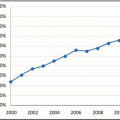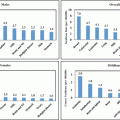Fig. 2.1
A cancer awareness poster designed for use in African Health Centres
National Cancer Control Plan
A National Cancer Control Plan (NCCP) defines a nation’s strategy for preventing, detecting, treating and providing palliative care for cancer. There are a number of steps needed to begin developing an NCCP:
Establish a National Cancer Control Committee of Oncology experts, Health Ministry Officials and NGOs
Use the committee to research the actual burden of cancer within the country and the current resources the country has
From this assessment establish what resources will be needed to help reduce the burden of cancer within the country and which cancers and care models should be prioritized
Write the national cancer plan based on these assessments, prioritizing steps that the National Health service needs to take to reduce the burden of disease
All NCCPs should) include the seven elements of cancer control:
Cancer intelligence units
Tobacco control
Awareness raising and advocacy from civil society
Early diagnosis and prevention
Cure the curable
Palliative care
Training and education
Health economy and budgeting individual elements of the plan
Cancer Intelligence Units
A cancer intelligence unit or registry is a vehicle to enable the systematic collection of regionally relevant data on cancer incidence, making it possible to assess reliably the types and prevalence of cancers experienced by populations in low to middle income countries, assess changes in these patterns over time and, therefore, assess the effect of any interventions associated with the cancer control programme.
There are two different types of cancer intelligence unit:
Hospital-Based Registries (HBR) , collect data on all patients diagnosed and treated for cancer within that hospital or collection of hospitals.
Population-Based Registries (PBR) , collect data on new incidences of cancer in a geographical region with a population of 100,000 or more to meaningfully extrapolate data on cancer for an entire population of their country.
PBRs are the most reliable way to collect data on cancers that are effecting.
Cancer registries also form a useful framework for evidence-based cancer research and, therefore, the lack of provision is undermining research capacity within low to middle income countries.
In common with all other areas of cancer control, there is a need for infrastructure, appropriate software and hardware, human resources and training, together with incentives for sustainability. The obvious partner to drive this programme forward is the International Agency for Research on Cancer (IARC) —the world leader in this field. IARC has developed a cost-effective training programme with scalable capacity to accommodate more trainees from low to middle income countries.
The World Health Organization (WHO), IARC has created the Global Initiative for Cancer Registry Development (GICR) .
Tobacco Control
Tobacco-related illness already kills 5.4 million people globally a year if current trends continue smoking will kill more than eight million a year by 2030 of which 80 % [4] will be in low and middle income countries, in relation to cancer smokin g is liked linked to cancers of the lung, throat, mouth, pancreas, bladder, stomach, liver and kidney.
Further, decreasing markets for the tobacco industry in high income countries cause the industry to seek new markets, such as in sub-Saharan Africa, where it sees enormous potential for growth.
Use of chewed tobacco is high in some nations, especially in villages in rural areas. Efforts must be made to control this more traditional use of tobacco in order to avert cancers of the mouth and throat.
It is possible to avert the epidemic of tobacco-related morbidity and mortality manifest, we need to educate civil society about the dangers of tobacco use and the benefits of cessation, special efforts are needed to educate young people, health care practitioners and policymakers. It is necessary to adopt effective policies such as tax and price increases on tobacco, which will not only lower prevalence but also increase government revenues, which can be used to pay for tobacco control measures and other health and social programmes. Other required policy changes include the placing of effective warning labels on tobacco products, banning advertising and promotion of tobacco use, prohibiting smoking in public places, banning sales of single cigarettes and prohibiting the sales of tobacco to the young. In order to implement effective tobacco control policies and programmes, civil society must be mobilized in support of this issue. A key to this is the nomination of champions who will promote the cause of tobacco control. Such individual champions throughout the world have proved to be essential in influencing policymakers, educating civil society and exposing and fighting the tactics of the tobacco industry.
In countries where farmers rely on growing tobacco for income, support needs to be provided to farmers to encourage planting of alternative crops, and to establish the infrastructure for distribution of the alternative crops.
Surveillance data are needed to track tobacco use and related behaviours, knowledge and attitudes. Without such data evaluations of tobacco control programmes are not possible.
Most importantly with tobacco control, we need to educate and raise awareness about populations, the damage smoking does to your health and how it affects you and others around you.
Early Diagnosis and Prevention
Liver cancer [predominantly hepatocellular carcinoma (HCC ) ] has one of the highest mortality rates of cancer in low to middle income countries. The main aetiological agents are chronic infections by hepatitis viruses, mainly hepatitis B (HBV) , which is endemic throughout these countries and present in 8–10 % of the general population. The effect of HBV is compounded by widespread exposure to a potent carcinogen, aflatoxin and a mycotoxin that contaminates staple diets.
Thus, the two main risk factors for HCC are relatively well known and effective strategies are at hand to reduce their effect. A safe and efficient HBV vaccine has been available since the early 1982. Simple, behavioural methods to reduce aflatoxin exposure have been tested in the field, with significant improvements on individual contamination.
HBV is available in ) 116 countries worldwide with the Global Alliance for Vaccines (GAVI) ensuring it is available to all poorer nations by the end of 2015.
Worldwide there are more than 273,000 deaths from cervical cancer each year, and it accounts for 9 % of female cancer deaths. Mortality rates vary 17-fold between the different regions of the world. Cervical cancer contributes over 2.7 million years of life lost among women between the ages of 25 and 64 worldwide, of which, tellingly, some 2.4 million occur in developing areas and only 300,000 in developed countries. Cervical cancer incidence and mortality rates have decreased substantially in high income countries following the introduction of screening; however, such programmes are either rudimentary or non-existent in low to middle income countries. The vast majority of women who suffer cervical cancer in these countries present with disease advanced far beyond the capacity of surgery or other treatment modalities to offer cure. Palliative care services are poorly developed and, therefore, these unfortunate women are often sentenced to a miserable end of life.
Human papillomavirus (HPV ) types 16 and 18 cause 70 % of cervical cancer cases and two vaccines that guard against these HPV types have been developed by the pharmaceutical industry. There is a large, international trials database that suggests that these vaccines can offer 100 % protection against infection by these HPV types (given as three injections over 6 months). The data are sufficiently compelling that the UK recently announced its commitment to a national vaccination programme for all 12–13-year-old girls. These remarkable vaccines give us the opportunity to eradicate 70 % of all known cervical cancer within a generation, saving almost 200,000 lives per annum, the vast majority in the developing world. GAVI is also helping to introduce HPV vaccinations to low income countries.
High income countries have reduced the burden of cancer in their populations by the screening of vulnerable groups, identified through their cancer surveillance programmes, for example, in the UK all women over 25 are invited to cervical cancer screening to check for precancerous lesions. In low to middle income countries, these programmes are in their infancy, using techniques such as Visual Inspection by Acetic Acid (VIA ) and new DNA marker tests.
Cure the Curable
Although treatment is often considered to be overemphasized relative to primary prevention, it has been estimated that between that between 2012 and 2030 that cancer annual cancer cases will increase to 22 million a year (from 14 million in 2012) 13.2 million of these cases will be in low to middle income countries. Although it is crucially important to institute primary preventive measures, even if all such measures were fully implemented today they would have little effect on cancer mortality in the next 10–15 years. Mortality: incidence ratios are much higher in low to middle income countries than in more affluent world regions, and therefore improved access to proven, cost-effective therapy, efficiently delivered, would save many lives. However, as the majority of poorer patients present with advanced disease, when cure is unlikely, treatment programmes must be undertaken in concert with attempts to diagnose cancer earlier; it is essential, if such programmes are to be successful, that patients diagnosed with early-stage cancer have immediate access to care, with a preliminary focus on childhood cancer.
Stay updated, free articles. Join our Telegram channel

Full access? Get Clinical Tree





